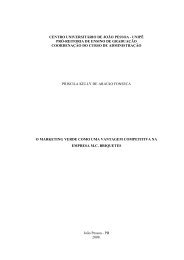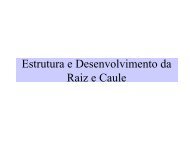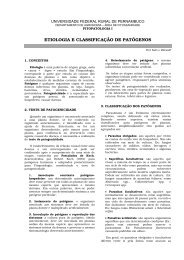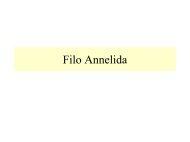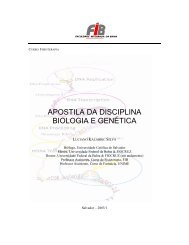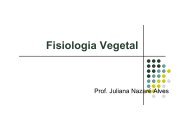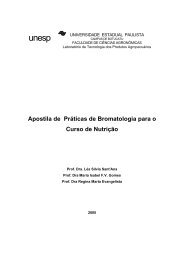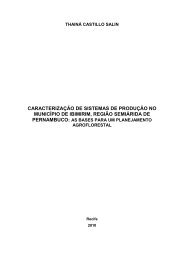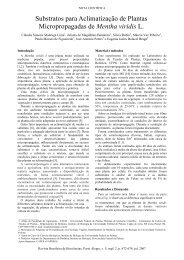Influência do microclima de um sistema agroflorestal na cultura da ...
Influência do microclima de um sistema agroflorestal na cultura da ...
Influência do microclima de um sistema agroflorestal na cultura da ...
Create successful ePaper yourself
Turn your PDF publications into a flip-book with our unique Google optimized e-Paper software.
ISSN 0104-1347<br />
Revista Brasileira <strong>de</strong> Agrometeorologia, Santa Maria, v. 11, n. 1, p. 91-97, 2003<br />
Recebi<strong>do</strong> para publicação em 31/12/2002. Aprova<strong>do</strong> em 09/06/2003.<br />
<strong>Influência</strong> <strong>do</strong> <strong>microclima</strong> <strong>de</strong> <strong>um</strong> <strong>sistema</strong> <strong>agroflorestal</strong> <strong>na</strong><br />
<strong>cultura</strong> <strong>da</strong> erva-mate (Ilex paraguariensis St. Hil)<br />
Influence of the agroforest <strong>microclima</strong>te on the erva-mate (Ilex<br />
paraguariensis St. Hil) crop<br />
A<strong>na</strong> Rita Rodrigues Vieira 1 , Carlos Eduar<strong>do</strong> <strong>de</strong> Oliveira Suertegaray 2 , Arno Ber<strong>na</strong>r<strong>do</strong> Heldwein 2 ,<br />
Marcelo Maraschin 4 e Apareci<strong>do</strong> Lima <strong>da</strong> Silva 4<br />
Res<strong>um</strong>o – O presente trabalho foi realiza<strong>do</strong> no distrito <strong>de</strong> Campo <strong>do</strong> Meio, município <strong>de</strong> Gentil, região <strong>do</strong><br />
Pla<strong>na</strong>lto Médio <strong>do</strong> Rio Gran<strong>de</strong> <strong>do</strong> Sul, e teve por objetivo avaliar o crescimento e a produção <strong>de</strong> biomassa <strong>da</strong><br />
erva-mate, sob as condições microclimáticas produzi<strong>da</strong>s pelo <strong>sistema</strong> <strong>agroflorestal</strong> <strong>de</strong> erva-mate com araucária<br />
(SAF) em relação aos <strong>sistema</strong>s <strong>de</strong> monocultivo (PS). Em ca<strong>da</strong> <strong>sistema</strong> <strong>de</strong> cultivo foi monitora<strong>da</strong> a radiação<br />
fotossinteticamente ativa, a temperatura <strong>do</strong> ar e a <strong>um</strong>i<strong>da</strong><strong>de</strong> relativa <strong>do</strong> ar, nos perío<strong>do</strong>s <strong>de</strong> frutificação e<br />
maturação, a primeira <strong>na</strong> estação <strong>do</strong> verão e a segun<strong>da</strong> no inverno. Através <strong>da</strong>s medi<strong>da</strong>s <strong>de</strong> radiação solar,<br />
foram estabeleci<strong>do</strong>s os níveis <strong>de</strong> luz recebi<strong>do</strong>s pelas plantas <strong>de</strong> erva-mate sombrea<strong>da</strong>s pela Floresta <strong>de</strong> Araucária,<br />
os quais origi<strong>na</strong>ram os tratamentos <strong>de</strong> luz: T1 (22%); T2 (39%); T3 (62%); T4 (78%); T5 (91%) e T6 (pleno<br />
sol). Avaliou-se as variáveis área foliar e fitomassa úmi<strong>da</strong>. Os resulta<strong>do</strong>s <strong>de</strong>monstraram que as diferenças<br />
microclimáticas <strong>do</strong>s <strong>sistema</strong>s agroflorestais e <strong>do</strong>s monocultivos po<strong>de</strong> ser evi<strong>de</strong>ncia<strong>da</strong> pelos valores <strong>de</strong> temperaturas<br />
máximas e mínimas absolutas e pela amplitu<strong>de</strong> <strong>de</strong> variação <strong>de</strong>sses parâmetros. A radiação solar foi o<br />
parâmetro que exerceu maior influência <strong>na</strong> área folhar e produção <strong>de</strong> fitomassa <strong>da</strong> erva-mate. Os efeitos<br />
microclimáticos influenciaram o crescimento <strong>da</strong>s plantas <strong>de</strong> erva-mate in<strong>de</strong>pen<strong>de</strong>nte <strong>do</strong> estádio <strong>de</strong> <strong>de</strong>senvolvimento.<br />
Palavras-chave: radiação solar; erva-mate; área folhar; fitomassa.<br />
Abstract – The present study was carried out at Gentil city (Rio Gran<strong>de</strong> <strong>do</strong> Sul State) and aimed at to evaluate<br />
the growth and biomass production of Ilex paraguariensis (erva-mate) upon distinct <strong>microclima</strong>tic conditions,<br />
i.e., agroforest system (I. paraguariensis culture plus Araucaria angustifolia - SAF) and monoculture system<br />
(I. paraguariensis culture solely - PS). For each culture system the photosynthetically active radiation, the<br />
temperature, and the relative h<strong>um</strong>idity of air were monitored during the periods of fruit-set and ripening of<br />
erva-mate, over two seasons (winter and s<strong>um</strong>mer). By measuring the sun radiation, it was established the<br />
levels of light received by I. paraguariensis plants in the SAF, which lea<strong>de</strong>d to the following treatments: T1:<br />
(22%); T2: (39%); T3: (62%); T4: (78%); T5: (91%) and T6: (100% full sunlight). The effect of the treatments<br />
was evaluated on leaf area and phytomass production. The results showed that the differences between SAF<br />
and PS <strong>microclima</strong>tes were better evi<strong>de</strong>nced by monitoring maxim<strong>um</strong> and minim<strong>um</strong> absolute temperatures, as<br />
well as by the range of variation of these parameters. The solar radiation was the most important parameter<br />
for comparison of the changes of leaf area and I. paraguariensis biomass production. Furthermore, it was<br />
noticed that the <strong>microclima</strong>te conditions strongly influenced the growth of I. paraguariensis regardless the<br />
phenological stage assayed.<br />
Key words: <strong>microclima</strong>te; Ilex paraguariensis; leaf area; phytomass.<br />
1Dr. , Prof. Adj., Dept° <strong>de</strong> Fitotecnia, CCA/UFSC- Ro<strong>do</strong>via Admar Gonzaga, 1340. Itacorubi. Florianópolis. CX. P.476. CEP: 88040-900; e-mail:<br />
arvieira@mbox1.ufsc.br.<br />
2Mestre em Agroecos<strong>sistema</strong>s,eng. Florestal, técnico <strong>da</strong> EMATER-RS.<br />
3Dr., Prof. Titular, Dept° <strong>de</strong> Fitotecnia, CCR/UFSM, Santa Maria-RS, bolsista <strong>do</strong> CNPq; heldwein@ccr.ufsm.br<br />
4Dr. Prof. Adj.; Depto <strong>de</strong> Fitotecnia, CCA/UFSC.
92<br />
Introdução<br />
VIEIRA, A.R.R. et al. - <strong>Influência</strong> <strong>do</strong> <strong>microclima</strong> <strong>de</strong> <strong>um</strong> <strong>sistema</strong> <strong>agroflorestal</strong> <strong>na</strong> <strong>cultura</strong> <strong>da</strong> erva-mate...<br />
A área <strong>de</strong> ocorrência <strong>na</strong>tural <strong>da</strong> erva-mate<br />
(Ilex paraguariensis St. Hil) se restringe a quatro países:<br />
Brasil, Paraguai, Uruguai e Argenti<strong>na</strong>. No Brasil,<br />
sua área está dispersa principalmente nos Esta<strong>do</strong>s<br />
<strong>do</strong> Paraná, Santa Catari<strong>na</strong> e Rio Gran<strong>de</strong> <strong>do</strong> Sul e ain<strong>da</strong><br />
<strong>um</strong>a parte <strong>do</strong> Mato Grosso <strong>do</strong> Sul e em São Paulo<br />
(EDWIN e REITZ, 1967) .<br />
De acor<strong>do</strong> com ANDRADE (1999), a região<br />
Sul <strong>do</strong> Brasil é responsável por cerca <strong>de</strong> 97% <strong>da</strong> produção<br />
<strong>na</strong>cio<strong>na</strong>l <strong>de</strong> erva-mate, sen<strong>do</strong> a maior parte <strong>da</strong><br />
matéria prima proveniente <strong>do</strong>s ervais <strong>na</strong>tivos, os quais<br />
têm sua maior ocorrência no Esta<strong>do</strong> <strong>do</strong> Paraná. O<br />
Rio Gran<strong>de</strong> <strong>do</strong> Sul, no início <strong>da</strong> déca<strong>da</strong> <strong>de</strong> 70, era o<br />
principal produtor com 50% <strong>da</strong> produção <strong>na</strong>cio<strong>na</strong>l,<br />
ten<strong>do</strong> reduzi<strong>do</strong> sua participação para 25% <strong>do</strong> montante<br />
total em 1989. Porém, neste Esta<strong>do</strong> é cons<strong>um</strong>i<strong>da</strong><br />
ain<strong>da</strong> 50-60% <strong>da</strong> erva-mate comercializa<strong>da</strong> no país<br />
(HEINRICHS e MALAVOLTA, 2001).<br />
O <strong>sistema</strong> extrativista utiliza<strong>do</strong> no início <strong>do</strong><br />
ciclo <strong>da</strong> erva-mate, alia<strong>do</strong> aos bons preços pagos aos<br />
grãos como soja e milho, <strong>de</strong>senca<strong>de</strong>ou <strong>um</strong>a instabili<strong>da</strong><strong>de</strong><br />
econômica para a <strong>cultura</strong>. A exploração <strong>de</strong>ste<br />
recurso <strong>na</strong>tural <strong>de</strong> forma <strong>de</strong>sorganiza<strong>da</strong>, sem técnicas<br />
a<strong>de</strong>qua<strong>da</strong>s e visão preservacionista, fez com que<br />
boa parte <strong>do</strong>s ervais <strong>na</strong>tivos juntamente com seu<br />
habitat <strong>de</strong> florestas <strong>na</strong>tivas fossem erradica<strong>do</strong>s, <strong>da</strong>n<strong>do</strong><br />
lugar às explorações agrícolas. Isto reduziu a oferta<br />
<strong>de</strong> matéria prima para a indústria ervateira, provocan<strong>do</strong><br />
<strong>um</strong>a elevação <strong>do</strong>s preços. Os produtores motiva<strong>do</strong>s<br />
por esta alta implantaram reflorestamentos com<br />
erva-mate em monocultivos (LINHARES, 1969).<br />
Na déca<strong>da</strong> <strong>de</strong> 90, to<strong>da</strong>via, constatou-se o retorno<br />
<strong>do</strong> plantio <strong>de</strong> erva-mate como <strong>um</strong>a forma <strong>de</strong><br />
enriquecimento <strong>de</strong> florestas, através <strong>do</strong> cultivo consorcia<strong>do</strong><br />
com outras espécies florestais, ou até mesmo<br />
com <strong>cultura</strong>s anuais, buscan<strong>do</strong> a melhoria <strong>da</strong> quali<strong>da</strong><strong>de</strong><br />
<strong>da</strong> matéria prima e o maior rendimento econômico.<br />
Além disto, a diferenciação nos valores <strong>da</strong><br />
matéria prima pagos aos produtores tem si<strong>do</strong> observa<strong>da</strong>,<br />
consoante ao <strong>sistema</strong> <strong>de</strong> cultivo utiliza<strong>do</strong>, isto<br />
é, a pleno sol ou em ambiente sombrea<strong>do</strong>. Esta situação<br />
<strong>de</strong>corre <strong>da</strong> alegação <strong>de</strong> que a fitomassa oriun<strong>da</strong><br />
<strong>de</strong> cultivos em ambientes sombrea<strong>do</strong>s apresenta “gosto<br />
mais suave” em relação à erva cultiva<strong>da</strong> a pleno<br />
sol e, por isto, alcança maior preço no merca<strong>do</strong>. Em<br />
função <strong>de</strong>ste contexto, as peque<strong>na</strong>s proprie<strong>da</strong><strong>de</strong>s rurais,<br />
responsáveis por 90% <strong>da</strong> produção <strong>de</strong> erva-mate<br />
<strong>na</strong> Região Sul <strong>do</strong> Brasil, têm encontra<strong>do</strong> dificul<strong>da</strong>-<br />
<strong>de</strong>s para a ven<strong>da</strong> <strong>do</strong> produto originário <strong>de</strong> plantios<br />
homogêneos (DA CROCE, 1996).<br />
Os fatores que concorrem para a diferenciação<br />
no sabor <strong>da</strong> erva-mate têm si<strong>do</strong> objeto <strong>de</strong> especulações,<br />
sen<strong>do</strong> os fatores promotores <strong>de</strong>ssas diferenças<br />
pouco conheci<strong>do</strong>s. Uma <strong>da</strong>s dificul<strong>da</strong><strong>de</strong>s nessa<br />
<strong>de</strong>termi<strong>na</strong>ção é a caracterização microclimática <strong>do</strong>s<br />
ambientes <strong>de</strong> <strong>sistema</strong>s agroflorestais on<strong>de</strong> a espécie<br />
é cultiva<strong>da</strong>, <strong>de</strong>vi<strong>do</strong> a heterogenei<strong>da</strong><strong>de</strong> <strong>da</strong> distribuição<br />
<strong>de</strong> radiação solar <strong>na</strong>queles ambientes e, por conseqüência,<br />
<strong>da</strong> quali<strong>da</strong><strong>de</strong> <strong>da</strong> luz disponível às plantas.<br />
O macroclima <strong>da</strong>s regiões produtoras no Sul<br />
<strong>do</strong> Brasil é caracteriza<strong>do</strong> por precipitações médias<br />
anuais em torno <strong>de</strong> 1500mm, varian<strong>do</strong> <strong>de</strong> 1100 a<br />
2300mm (CARVALHO, 1994). O regime <strong>de</strong> chuvas<br />
é uniforme ou estacio<strong>na</strong>l <strong>na</strong> maior parte <strong>da</strong> área <strong>de</strong><br />
ocorrência (Região Sul), sen<strong>do</strong> as chuvas concentra<strong>da</strong>s<br />
no verão e as estações secas pouco pronuncia<strong>da</strong>s<br />
ou ausentes no inverno. A temperatura média anual<br />
<strong>do</strong> ar nessas regiões situa-se entre 12 e 24ºC, com<br />
maior ocorrência entre 15 a 18ºC. A temperatura<br />
média <strong>do</strong> ar <strong>do</strong> mês mais frio <strong>na</strong>s regiões produtoras<br />
situa-se entre 8 e 19ºC, sen<strong>do</strong> que nos locais mais<br />
frios po<strong>de</strong> ocorrer <strong>um</strong>a alta freqüência <strong>de</strong> gea<strong>da</strong>s. Além<br />
disto, no que concerne à radiação solar, a erva-mate<br />
a<strong>da</strong>pta-se à sombra em qualquer i<strong>da</strong><strong>de</strong>, toleran<strong>do</strong> ple<strong>na</strong><br />
exposição à radiação solar e ao frio <strong>na</strong> fase adulta.<br />
Sua ocorrência foi observa<strong>da</strong> em regiões frias, <strong>na</strong>s<br />
quais os valores <strong>de</strong> temperatura mínima absoluta <strong>do</strong><br />
ar po<strong>de</strong>m atingir até -12ºC (CARVALHO, 1994).<br />
Portanto, os elementos climáticos po<strong>de</strong>m atuar como<br />
fatores limitantes <strong>da</strong> produção <strong>da</strong> erva-mate. Da<strong>do</strong>s<br />
<strong>de</strong> FERREIRA et al. (1994) mostram que o<br />
<strong>microclima</strong> po<strong>de</strong> alterar a <strong>da</strong>ta <strong>de</strong> ocorrência <strong>do</strong>s estádios<br />
<strong>de</strong> <strong>de</strong>senvolvimento <strong>da</strong> planta em alg<strong>um</strong>as regiões<br />
<strong>do</strong> Sul <strong>do</strong> Brasil .<br />
Em <strong>sistema</strong>s complexos como os <strong>sistema</strong>s<br />
agroflorestais os efeitos <strong>da</strong> l<strong>um</strong>inosi<strong>da</strong><strong>de</strong>, temperatura<br />
e <strong>um</strong>i<strong>da</strong><strong>de</strong> <strong>do</strong> ar e <strong>do</strong> solo sobre o crescimento e<br />
<strong>de</strong>senvolvimento <strong>da</strong>s plantas <strong>de</strong> erva-mate mostramse<br />
sobremaneira importantes, principalmente pela<br />
competição por luz que se estabelece <strong>na</strong>queles ambientes.<br />
O crescimento <strong>de</strong> caules e folhas <strong>da</strong> erva-mate<br />
po<strong>de</strong>rá ser severamente limita<strong>do</strong> sob condições <strong>de</strong><br />
sombreamento excessivo por outras espécies<br />
(GLIESSMANN, 2000).<br />
RACHWAL et al. (1998) e RACHWAL et al.<br />
(2000) concluíram que o fator l<strong>um</strong>inosi<strong>da</strong><strong>de</strong> ou<br />
radiação fotossinteticamente ativa, alia<strong>do</strong> a época <strong>de</strong><br />
po<strong>da</strong>, induziram variações nos teores <strong>do</strong>s compostos
químicos vincula<strong>do</strong>s ao sabor. To<strong>da</strong>via, os mesmos<br />
autores reportaram a não ocorrência <strong>de</strong> diferenças<br />
significativas nos teores <strong>de</strong> cálcio, magnésio, potássio<br />
e fósforo(p< 0,05) entre os níveis <strong>de</strong> l<strong>um</strong>inosi<strong>da</strong><strong>de</strong><br />
77,5% e 19,0%. Os teores foliares <strong>de</strong> potássio foram<br />
inferiores enquanto o conteú<strong>do</strong> <strong>de</strong> taninos mostrouse<br />
mais eleva<strong>do</strong> no sítio com maior l<strong>um</strong>inosi<strong>da</strong><strong>de</strong><br />
relativa (77,5%).<br />
KASPARY (1985) verificou valores superiores<br />
<strong>de</strong> área folhar, altura <strong>do</strong> caule e produção <strong>de</strong> massa<br />
<strong>de</strong> matéria seca <strong>de</strong> plantas jovens sob condições <strong>de</strong><br />
sombreamento, ten<strong>de</strong>n<strong>do</strong> à redução com o a<strong>um</strong>ento<br />
<strong>da</strong> intensi<strong>da</strong><strong>de</strong> l<strong>um</strong>inosa <strong>de</strong> 20% para 60%. No entanto,<br />
o número <strong>de</strong> ramificações e a taxa fotossintética<br />
foram superiores no tratamento <strong>de</strong> ple<strong>na</strong> luz.<br />
Ao avaliar o efeito interativo <strong>do</strong><br />
sombreamento e <strong>da</strong> disponibili<strong>da</strong><strong>de</strong> hídrica,<br />
FERREIRA et al. (1994) observaram maior crescimento<br />
<strong>de</strong> mu<strong>da</strong>s, evi<strong>de</strong>ncia<strong>do</strong> pela <strong>de</strong>termi<strong>na</strong>ção <strong>de</strong><br />
peso seco, altura, área folhar e vigor <strong>da</strong>s plantas, com<br />
60% a 80% <strong>de</strong> sombreamento em relação aos <strong>de</strong>mais<br />
tratamentos. Foi também inferi<strong>do</strong> pelos autores que<br />
teores <strong>de</strong> <strong>um</strong>i<strong>da</strong><strong>de</strong> <strong>do</strong> solo em torno <strong>de</strong> 60% po<strong>de</strong>m<br />
ser limitantes ao crescimento <strong>da</strong>s plantas, principalmente<br />
àquelas expostas a pleno sol em épocas <strong>de</strong> temperaturas<br />
mais eleva<strong>da</strong>s. Este resulta<strong>do</strong> sugere que a<br />
<strong>cultura</strong> não necessita <strong>de</strong> reposição integral <strong>de</strong> água<br />
para melhorar o seu <strong>de</strong>sempenho, principalmente sob<br />
sombreamento.<br />
Os diversos estu<strong>do</strong>s têm consi<strong>de</strong>ra<strong>do</strong>, portanto,<br />
que o <strong>microclima</strong> e, em especial a l<strong>um</strong>inosi<strong>da</strong><strong>de</strong>,<br />
é <strong>um</strong> fator <strong>de</strong>termi<strong>na</strong>nte <strong>da</strong>s características <strong>de</strong> alteração<br />
<strong>de</strong> área folhar e fitomassa nos cultivos <strong>de</strong> ervamate.<br />
Em face disso, neste trabalho objetivou-se caracterizar<br />
as diferenças <strong>de</strong> temperatura e <strong>um</strong>i<strong>da</strong><strong>de</strong> relativa<br />
<strong>do</strong> ar em <strong>do</strong>is ambientes <strong>de</strong> cultivo: <strong>sistema</strong><br />
<strong>agroflorestal</strong> (SAF) e cultivo a pleno sol (PS), e avaliar<br />
o efeito <strong>do</strong>s níveis <strong>de</strong> luz <strong>do</strong> SAF e <strong>do</strong> PS sobre a<br />
área folhar e produção <strong>de</strong> biomassa <strong>de</strong> Ilex<br />
paraguariensis.<br />
Material e Méto<strong>do</strong>s<br />
O experimento foi realiza<strong>do</strong> em <strong>do</strong>is <strong>sistema</strong>s<br />
<strong>de</strong> cultivo <strong>de</strong> erva-mate: a) erval planta<strong>do</strong> sob<br />
sombreamento <strong>de</strong> remanescente <strong>de</strong> Floresta Mista,<br />
com pre<strong>do</strong>minância <strong>de</strong> Araucária angustifolia (SAF)<br />
e b) monocultivo <strong>de</strong> erva-mate, sen<strong>do</strong> a <strong>cultura</strong> planta<strong>da</strong><br />
em condições <strong>de</strong> pleno sol (PS). Os ervais, situa<strong>do</strong>s<br />
<strong>na</strong> locali<strong>da</strong><strong>de</strong> <strong>de</strong> Campo <strong>do</strong> Meio, município <strong>de</strong><br />
Rev. Bras. Agrometeorologia, v. 11, n. 1, p. 91-97, 2003<br />
93<br />
Gentil–RS (latitu<strong>de</strong> = 28º 26’S; longitu<strong>de</strong> = 52º 02’W;<br />
altitu<strong>de</strong> = 800m) eram constituí<strong>do</strong>s por plantas com<br />
5 anos <strong>de</strong> i<strong>da</strong><strong>de</strong>. Nestes ervais, e para efeitos <strong>de</strong><br />
amostragem nos cultivos a “pleno sol” e “sombrea<strong>do</strong>s”<br />
foram utiliza<strong>da</strong>s áreas com 200 m 2 ca<strong>da</strong>.<br />
A implantação <strong>do</strong>s cultivos foi efetua<strong>da</strong> no<br />
ano <strong>de</strong> 1996, sen<strong>do</strong> as mu<strong>da</strong>s produzi<strong>da</strong>s e origi<strong>na</strong><strong>da</strong>s<br />
<strong>de</strong> sementes <strong>de</strong> <strong>um</strong>a mesma planta matriz. O<br />
espaçamento utiliza<strong>do</strong> no <strong>sistema</strong> <strong>de</strong> monocultivo<br />
(PS) foi <strong>de</strong> 3,0m entre linhas e <strong>de</strong> 1,5m <strong>na</strong> linha <strong>de</strong><br />
plantio. O manejo nutricio<strong>na</strong>l <strong>do</strong> cultivo não utilizou<br />
adubação química, sen<strong>do</strong> a<strong>do</strong>ta<strong>da</strong> a cobertura ver<strong>de</strong><br />
em ambiente <strong>de</strong> cultivo a pleno sol e a regeneração<br />
<strong>na</strong>tural <strong>na</strong> área <strong>de</strong> SAF.<br />
A caracterização <strong>do</strong>s ambientes foi realiza<strong>da</strong><br />
através <strong>da</strong> <strong>de</strong>termi<strong>na</strong>ção durante alguns dias <strong>do</strong>s seguintes<br />
parâmetros meteorológicos: radiação solar<br />
fotossinteticamente ativa, temperatura <strong>do</strong> ar e <strong>um</strong>i<strong>da</strong><strong>de</strong><br />
<strong>do</strong> ar. Os <strong>da</strong><strong>do</strong>s <strong>de</strong> radiação solar<br />
fotossinteticamente ativa (RFA ou luz), medi<strong>do</strong>s com<br />
o ceptômetro <strong>de</strong> barra Accupar, o qual possui <strong>um</strong>a<br />
barra <strong>de</strong> 80cm com 80 sensores, foram utiliza<strong>do</strong>s para<br />
<strong>de</strong>finir os tratamentos <strong>de</strong> luz inci<strong>de</strong>nte sobre as plantas<br />
<strong>de</strong> erva-mate. Para tal, e consi<strong>de</strong>ran<strong>do</strong> a ocorrência<br />
<strong>de</strong> variações nos níveis <strong>de</strong> intensi<strong>da</strong><strong>de</strong> l<strong>um</strong>inosa<br />
recebi<strong>da</strong> pelos vegetais ao longo <strong>do</strong> perío<strong>do</strong> experimental,<br />
medi<strong>da</strong>s horárias (8 às 18 horas) <strong>de</strong>ste<br />
parâmetro foram realiza<strong>da</strong>s previamente, durante três<br />
dias e sob condições <strong>de</strong> radiação solar distintas, entre<br />
os meses <strong>de</strong> junho e novembro/2000, nos <strong>sistema</strong>s <strong>de</strong><br />
cultivo PS (monocultivo) e SAF. A partir <strong>da</strong>s medi<strong>da</strong>s<br />
<strong>de</strong> radiação solar fotossinteticamente ativa, foram<br />
<strong>de</strong>fini<strong>do</strong>s os tratamentos <strong>de</strong> luz recebi<strong>do</strong>s pelas<br />
plantas <strong>de</strong> erva-mate, conforme a relação:<br />
RFA<br />
N luz =<br />
RFA<br />
SAF<br />
PS<br />
(1)<br />
em que N luz é o nível <strong>de</strong> luz recebi<strong>do</strong> pela erva-mate<br />
(%), RFA SAF a RFA sobre a erva-mate abaixo <strong>da</strong><br />
araucária e RFA PS a RFA a pleno sol.<br />
Esses tratamentos foram caracteriza<strong>do</strong>s pelos<br />
níveis máximos <strong>de</strong> luz recebi<strong>do</strong>s pelas plantas <strong>de</strong><br />
erva-mate, a saber: T1-22%; T2-39%; T3-62%; T4-<br />
78%; T5- 91% e T6-pleno sol. Os níveis mínimos <strong>de</strong><br />
luz não foram consi<strong>de</strong>ra<strong>do</strong>s <strong>de</strong>vi<strong>do</strong> à peque<strong>na</strong> variação<br />
observa<strong>da</strong> entre to<strong>da</strong>s as plantas <strong>do</strong> SAF (2-4%).<br />
Os tratamentos não apresentaram o mesmo número<br />
<strong>de</strong> plantas porque o Sistema Agroflorestal é <strong>um</strong> <strong>sistema</strong><br />
em regeneração, on<strong>de</strong> o manejo aplica<strong>do</strong> não per-
94<br />
VIEIRA, A.R.R. et al. - <strong>Influência</strong> <strong>do</strong> <strong>microclima</strong> <strong>de</strong> <strong>um</strong> <strong>sistema</strong> <strong>agroflorestal</strong> <strong>na</strong> <strong>cultura</strong> <strong>da</strong> erva-mate...<br />
mite <strong>um</strong>a uniformização <strong>da</strong> sombra <strong>da</strong> araucária sob<br />
a erva-mate, ten<strong>do</strong> si<strong>do</strong> neste caso a<strong>na</strong>lisa<strong>da</strong> <strong>um</strong>a<br />
amostra <strong>de</strong> 20 árvores. O número mínimo <strong>de</strong> árvores<br />
por tratamento foi 2.<br />
Foram efetua<strong>da</strong>s medi<strong>da</strong>s <strong>de</strong> temperatura (T)<br />
e <strong>da</strong> <strong>um</strong>i<strong>da</strong><strong>de</strong> relativa <strong>do</strong> ar (UR) em to<strong>do</strong>s os tratamentos,<br />
nos perío<strong>do</strong>s <strong>de</strong> 26 a 31/12/00 e <strong>de</strong> 27/07 a<br />
10/08/01, correspon<strong>de</strong>n<strong>do</strong> aos estádios <strong>de</strong> <strong>de</strong>senvolvimento<br />
<strong>de</strong> frutificação e maturação <strong>do</strong>s frutos <strong>da</strong> ervamate,<br />
épocas em que ocorrem os cortes <strong>da</strong> safrinha e<br />
safra, respectivamente. A escolha <strong>de</strong>sses <strong>do</strong>is perío<strong>do</strong>s<br />
objetivou <strong>de</strong>termi<strong>na</strong>r as variações <strong>de</strong> composição<br />
química <strong>da</strong> erva-mate durante esses estádios <strong>de</strong> <strong>de</strong>senvolvimento,<br />
<strong>um</strong>a vez que <strong>da</strong><strong>do</strong>s relativos a este<br />
contexto são escassos (FERREIRA et al., 1994). Para<br />
tal, foram utiliza<strong>do</strong>s sensores <strong>de</strong> resistência elétrica<br />
<strong>de</strong> Plati<strong>na</strong> (Pt-100), instala<strong>do</strong>s <strong>na</strong> forma <strong>de</strong> pares<br />
psicrométricos não aspira<strong>do</strong>s. Os sensores Pt-100<br />
foram instala<strong>do</strong>s no interior <strong>de</strong> mini-abrigos <strong>de</strong> PVC,<br />
<strong>de</strong> pare<strong>de</strong> dupla e perfura<strong>da</strong> para a ventilação, e liga<strong>do</strong>s<br />
a <strong>um</strong> aquisitor eletrônico <strong>de</strong> <strong>da</strong><strong>do</strong>s. No “<strong>da</strong>taloger”<br />
eram armaze<strong>na</strong><strong>do</strong>s os valores médios <strong>de</strong> temperatura<br />
medi<strong>do</strong>s <strong>de</strong> forma simultânea a ca<strong>da</strong> 10 minutos nos<br />
<strong>do</strong>is ambientes <strong>de</strong> estu<strong>do</strong> (SAF e PS), sen<strong>do</strong> os<br />
miniabrigos com sensores Pt-100 seco e úmi<strong>do</strong> coloca<strong>do</strong>s<br />
à meia altura <strong>da</strong>s plantas <strong>de</strong> erva-mate, posição<br />
em que foram coleta<strong>da</strong>s as amostras <strong>de</strong> folhas para<br />
mensuração <strong>da</strong> área folhar. Instalou-se seis<br />
psicrômetros, sen<strong>do</strong> <strong>um</strong> para ca<strong>da</strong> planta representante<br />
<strong>de</strong> ca<strong>da</strong> nível <strong>de</strong> luz recebi<strong>da</strong>.<br />
No momento <strong>da</strong>s medições <strong>do</strong>s níveis <strong>de</strong><br />
intensi<strong>da</strong><strong>de</strong> l<strong>um</strong>inosa foram coleta<strong>da</strong>s 10 amostras <strong>de</strong><br />
folhas/planta <strong>de</strong> erva-mate, em duas plantas por<br />
tratamento, em ca<strong>da</strong> <strong>um</strong>a <strong>da</strong>s condições ambientais<br />
em estu<strong>do</strong>. Com este material <strong>de</strong>terminou-se a área<br />
folhar utilizan<strong>do</strong>-se o méto<strong>do</strong> <strong>do</strong> scanner proposto<br />
por FARIA et al. (1992), com o auxílio <strong>do</strong> Software<br />
Idrisi.<br />
A avaliação <strong>da</strong> produção <strong>de</strong> fitomassa úmi<strong>da</strong><br />
foi realiza<strong>da</strong> logo após sua coleta. A coleta foi feita<br />
em <strong>do</strong>is estádios <strong>de</strong> <strong>de</strong>senvolvimento (frutificação e<br />
maturação), perío<strong>do</strong>s em que as plantas se encontravam<br />
próprias para as colheitas <strong>de</strong> safrinha e safra,<br />
conforme prática <strong>da</strong> maioria <strong>do</strong>s produtores <strong>de</strong> ervamate<br />
<strong>da</strong> região. Os <strong>da</strong><strong>do</strong>s <strong>de</strong> <strong>microclima</strong> foram relacio<strong>na</strong><strong>do</strong>s<br />
à área folhar <strong>da</strong> erva-mate via análises <strong>de</strong><br />
regressão estima<strong>da</strong>s através <strong>do</strong> software J<strong>um</strong>p<br />
Discovery.<br />
Resulta<strong>do</strong>s e Discussão<br />
A diferença <strong>de</strong> temperatura média diária <strong>do</strong><br />
ar variou ape<strong>na</strong>s cerca <strong>de</strong> 0,5ºC entre os <strong>sistema</strong>s <strong>de</strong><br />
cultivo SAF e PS (Tabelas 1 e 2). No entanto, a variação<br />
<strong>da</strong> amplitu<strong>de</strong> <strong>de</strong> temperaturas máximas e a variação<br />
<strong>da</strong> amplitu<strong>de</strong> <strong>de</strong> temperaturas mínimas <strong>do</strong>s tratamentos<br />
SAF em relação ao tratamento PS, no inverno<br />
foi <strong>de</strong> 1,7 e 1,9ºC, respectivamente (Tabela 1),<br />
e no verão, 2,0 e 0,3ºC, respectivamente (Tabela 2).<br />
As diferenças extremas <strong>de</strong> temperatura máxima e temperatura<br />
mínima absolutas entre os tratamentos SAF<br />
e PS alcançou 3,3 e 0,5ºC, respectivamente no inverno<br />
(Tabela 1) e 4,4 e 0,5ºC, respectivamente, no verão<br />
(Tabela 2).<br />
Com relação à <strong>um</strong>i<strong>da</strong><strong>de</strong> relativa <strong>do</strong> ar, a diferença<br />
máxima obti<strong>da</strong> entre os tratamentos SAF e PS<br />
foi <strong>de</strong> 1% no inverno e 26% no verão. Os <strong>da</strong><strong>do</strong>s<br />
coleta<strong>do</strong>s mostraram ain<strong>da</strong> que a amplitu<strong>de</strong> <strong>de</strong> variação<br />
<strong>da</strong> <strong>um</strong>i<strong>da</strong><strong>de</strong> relativa <strong>do</strong> ar em condições <strong>de</strong> sol<br />
Tabela 1. Médias diárias <strong>de</strong> temperatura e <strong>um</strong>i<strong>da</strong><strong>de</strong> relativa <strong>do</strong> ar e amplitu<strong>de</strong> <strong>de</strong> variação térmica <strong>do</strong> ar nos diferentes<br />
níveis <strong>de</strong> luz, recebi<strong>do</strong>s pelas plantas <strong>de</strong> erva-mate (Ilex paraguariensis St. Hil.), no perío<strong>do</strong> <strong>de</strong> 27/07 a<br />
10/08/01. Gentil–RS, 2001.<br />
VariáveL<br />
Níveis <strong>de</strong> luz recebi<strong>do</strong>s<br />
22% 39% 62% 78% 91% Pleno sol<br />
Amplitu<strong>de</strong> <strong>da</strong>s temperaturas máximas (ºC ) 10,0 10,4 12,2 12,0 11,1 11,7<br />
Amplitu<strong>de</strong> <strong>da</strong>s temperaturas mínimas (ºC) 12,0 12,6 12,9 12,9 12,6 13,9<br />
Amplitu<strong>de</strong> <strong>de</strong> <strong>um</strong>i<strong>da</strong><strong>de</strong> relativa <strong>do</strong> ar(%) 20,1 14,5 16,3 18,6 20,4 14,0<br />
Temperatura máxima absoluta (ºC) 26,3 23,2 22,7 25,7 23,2 26,0<br />
Temperatura mínima absoluta (ºC) -1,3 -1,2 -1,3 -1,1 -1,2 -1,6<br />
Temperatura média (ºC) 14,2 14,0 14,0 14,1 14,0 14,2<br />
Umi<strong>da</strong><strong>de</strong> relativa média (%) 95,9 96,2 95,7 94,8 95,7 95,9
(PS) não é tão acentua<strong>da</strong> quanto <strong>na</strong>s condições <strong>de</strong><br />
sombreamento <strong>do</strong> SAF (14% e 20%, respectivamente).<br />
Nota-se, portanto, que os <strong>da</strong><strong>do</strong>s <strong>de</strong> amplitu<strong>de</strong><br />
<strong>de</strong> variação <strong>da</strong> temperatura e <strong>um</strong>i<strong>da</strong><strong>de</strong> relativa <strong>do</strong><br />
ar, bem como os valores absolutos <strong>de</strong> temperatura<br />
máxima e mínima <strong>do</strong> ar mostraram variações, especialmente<br />
em perío<strong>do</strong>s nos quais os <strong>da</strong><strong>do</strong>s médios <strong>de</strong><br />
temperatura <strong>do</strong> ar não mostraram diferenças entre os<br />
tratamentos (0,5ºC). Tal fato sugere que os valores<br />
extremos <strong>de</strong> temperatura e <strong>um</strong>i<strong>da</strong><strong>de</strong> <strong>do</strong> ar são mais<br />
a<strong>de</strong>qua<strong>do</strong>s para caracterizar as diferenças entre os<br />
<strong>microclima</strong>s existentes no SAF em comparação ao<br />
<strong>sistema</strong> <strong>de</strong> monocultivo (PS) e, por conseqüência, as<br />
alterações <strong>de</strong> área folhar e fitomassa existentes entre<br />
as plantas submeti<strong>da</strong>s aos diferentes tratamentos <strong>de</strong>ntro<br />
<strong>do</strong> SAF e a pleno sol. Estes <strong>da</strong><strong>do</strong>s evi<strong>de</strong>nciam a<br />
importância <strong>do</strong>s valores limitantes <strong>de</strong> temperatura<br />
muito eleva<strong>da</strong> para a erva-mate, que conforme<br />
FERREIRA et al. (1994) tor<strong>na</strong>m-se especialmente<br />
importantes quan<strong>do</strong> as temperaturas máximas <strong>do</strong> ar<br />
muito eleva<strong>da</strong>s ocorrem sob condições <strong>de</strong> <strong>de</strong>ficiência<br />
hídrica no solo e ou sob condições <strong>de</strong> alta <strong>de</strong>man<strong>da</strong><br />
evaporativa. Com relação a temperatura baixa,<br />
CARVALHO (1994) afirma que a erva-mate po<strong>de</strong> ser<br />
produzi<strong>da</strong> em regiões em que a temperatura mínima<br />
<strong>do</strong> ar atinge valores <strong>de</strong> até – 12°C, fato não observa<strong>do</strong><br />
<strong>na</strong>s condições experimentais <strong>do</strong> presente trabalho.<br />
Além disso, como planta C , a erva-mate apre-<br />
3<br />
senta ativi<strong>da</strong><strong>de</strong> metabólica sob condições <strong>de</strong> temperaturas<br />
<strong>do</strong> ar próximas a 0ºC, condição esta muito<br />
com<strong>um</strong> nos dias frios <strong>do</strong> inverno em regiões <strong>de</strong> ocorrência<br />
<strong>na</strong>tural <strong>da</strong> <strong>cultura</strong> on<strong>de</strong> as estações <strong>do</strong> ano são<br />
bem <strong>de</strong>fini<strong>da</strong>s, como <strong>na</strong> região <strong>do</strong> presente estu<strong>do</strong>.<br />
A l<strong>um</strong>inosi<strong>da</strong><strong>de</strong> mostrou forte influência sobre<br />
a área folhar (AF) <strong>da</strong> <strong>cultura</strong>. As regressões apresentaram<br />
coeficiente <strong>de</strong> <strong>de</strong>termi<strong>na</strong>ção (r 2 ) eleva<strong>do</strong> <strong>na</strong>s<br />
Rev. Bras. Agrometeorologia, v. 11, n. 1, p. 91-97, 2003<br />
Tabela 2. Médias diárias <strong>de</strong> temperatura e <strong>um</strong>i<strong>da</strong><strong>de</strong> relativa <strong>do</strong> ar e amplitu<strong>de</strong> <strong>de</strong> variação térmica nos diferentes<br />
níveis <strong>de</strong> luz, recebi<strong>do</strong>s pelas plantas <strong>de</strong> erva-mate (Ilex paraguariensis St. Hil.), no perío<strong>do</strong> <strong>de</strong> 26 a<br />
30/12/02, no município <strong>de</strong> Gentil–RS.<br />
Variável<br />
níveis <strong>de</strong> luz recebi<strong>do</strong>s<br />
22% 39% 62% 78% 91% pleno sol<br />
Amplitu<strong>de</strong> <strong>da</strong>s temperaturas máximas (ºC ) 9,7 10,2 19,0 10,5 10,2 11,7<br />
Amplitu<strong>de</strong> <strong>da</strong>s temperaturas mínimas (ºC) 5,5 5,5 5,9 5,7 5,7 5,8<br />
Amplitu<strong>de</strong> <strong>de</strong> <strong>um</strong>i<strong>da</strong><strong>de</strong> (%) 14,5 14,7 15,5 13,9 14,7 13,9<br />
Temperatura máxima absoluta (ºC) 28,4 28,7 30,9 29,0 28.7 32,8<br />
Temperatura mínima absoluta (ºC) 21,8 21,8 22,0 22,0 21,8 22,3<br />
Temperatura média (ºC) 21,3 21,3 21,5 21,2 21,3 22,7<br />
Umi<strong>da</strong><strong>de</strong> relativa média (%) 91,9 96,2 90,6 91.1 90.8 70,2<br />
95<br />
duas épocas (Tabela 3). O valor máximo <strong>de</strong> área folhar<br />
foi observa<strong>do</strong> no tratamento <strong>de</strong> 62% <strong>de</strong> luz (Figura<br />
1), sofren<strong>do</strong> <strong>de</strong>créscimos tanto em níveis mais altos<br />
<strong>de</strong> luz (78% e 91%), quanto em níveis inferiores <strong>de</strong><br />
l<strong>um</strong>inosi<strong>da</strong><strong>de</strong> (22% e 39%). Ain<strong>da</strong> assim, os valores<br />
<strong>de</strong> área folhar obti<strong>do</strong>s nos tratamentos 22%, 39% 78%<br />
e 91% <strong>de</strong> luz foram maiores <strong>do</strong> que no tratamento<br />
PS. Estes resulta<strong>do</strong>s são concor<strong>da</strong>ntes com MORAES<br />
et al. (2000) e FERREIRA et al. (1994), os quais verificaram<br />
que níveis <strong>de</strong> luz entre 20-60% mostraram<br />
<strong>um</strong> maior crescimento e <strong>de</strong>senvolvimento mais rápi<strong>do</strong><br />
<strong>de</strong> mu<strong>da</strong>s <strong>de</strong> erva-mate. RACHWAL et al. (1998)<br />
mostraram que houve <strong>de</strong>créscimo <strong>de</strong> área folhar <strong>da</strong><br />
erva-mate quan<strong>do</strong> a quanti<strong>da</strong><strong>de</strong> <strong>de</strong> luz inci<strong>de</strong>nte atingiu<br />
valores máximos <strong>de</strong> 78 a 100%. Além disso, a<br />
relação observa<strong>da</strong> entre a variação <strong>de</strong> área folhar e a<br />
radiação solar não mostrou-se linear, o que está em<br />
concordância com LARCHER (1995).<br />
Com relação à fitomassa úmi<strong>da</strong> (Figura 2)<br />
observaram-se variações entre os tratamentos, essencialmente<br />
em função <strong>do</strong>s níveis <strong>de</strong> luz. A maior produção<br />
<strong>de</strong> fitomassa foi obti<strong>da</strong> sob condições <strong>de</strong> cultivo<br />
a pleno sol (PS), segui<strong>do</strong> <strong>do</strong> tratamento 91% <strong>de</strong><br />
luz. Esses <strong>da</strong><strong>do</strong>s confirmam a teoria <strong>de</strong> INOUE (1976)<br />
<strong>de</strong> que as espécies <strong>um</strong>brófilas, embora possam suportar<br />
<strong>um</strong> grau <strong>de</strong> sombra eleva<strong>do</strong>, geralmente alcançam<br />
maiores valores <strong>de</strong> fitomassa quan<strong>do</strong> expostas à<br />
luz total, quan<strong>do</strong> ocorre, <strong>um</strong>a relativa a<strong>da</strong>ptação.<br />
LARCHER (1986) explica que características<br />
como tamanho e número <strong>de</strong> folhas, bem como<br />
a<strong>na</strong>tomia e morfologia <strong>da</strong> folha, segui<strong>da</strong> <strong>da</strong> estrutura<br />
celular e subcelular, <strong>da</strong> ativi<strong>da</strong><strong>de</strong> metabólica e <strong>do</strong> estádio<br />
<strong>de</strong> <strong>de</strong>senvolvimento <strong>da</strong> planta são <strong>de</strong>termi<strong>na</strong>ntes<br />
<strong>na</strong>s trocas <strong>de</strong> CO . KASPARY (1985) estu<strong>da</strong>n<strong>do</strong> os<br />
2<br />
efeitos <strong>de</strong> níveis <strong>de</strong> sombreamento sobre o <strong>de</strong>senvolvimento<br />
<strong>de</strong> plantas jovens (1 ano) <strong>de</strong> erva-mate, cons-
96<br />
VIEIRA, A.R.R. et al. - <strong>Influência</strong> <strong>do</strong> <strong>microclima</strong> <strong>de</strong> <strong>um</strong> <strong>sistema</strong> <strong>agroflorestal</strong> <strong>na</strong> <strong>cultura</strong> <strong>da</strong> erva-mate...<br />
Tabela 3 - Equações <strong>de</strong> regressão e coeficientes <strong>de</strong><br />
<strong>de</strong>termi<strong>na</strong>ção (r 2 ) referentes a influência <strong>da</strong><br />
l<strong>um</strong>inosi<strong>da</strong><strong>de</strong> sobre a área folhar <strong>da</strong>s plantas<br />
(AF) <strong>de</strong> erva-mate <strong>na</strong>s épocas <strong>de</strong> colheita <strong>de</strong><br />
inverno e verão.<br />
Época Equação <strong>de</strong> Regressão r 2<br />
Inverno* AF = 47,34 + 17,65 (%luz) – 0,15 (%luz 2<br />
) 0,98<br />
Verão** AF = -141,97 + 27,06 (%luz) - 0,24 (%luz 2 ) 0,88<br />
* Colheita <strong>da</strong> safrinha; ** Colheita <strong>da</strong> safra.<br />
tatou <strong>um</strong> maior número <strong>de</strong> folhas <strong>na</strong>quelas submeti<strong>da</strong>s<br />
a níveis máximos <strong>de</strong> luz. De forma similar,<br />
PINTRO (1986) correlacionou positivamente o incremento<br />
<strong>do</strong> número <strong>de</strong> folhas com a disponibili<strong>da</strong><strong>de</strong> <strong>de</strong><br />
água no solo.<br />
Como a presença <strong>da</strong> araucária po<strong>de</strong> propiciar<br />
níveis distintos <strong>de</strong> luz no ambiente <strong>de</strong> produção <strong>da</strong><br />
erva-mate e esta condição po<strong>de</strong> gerar alterações <strong>na</strong><br />
disponibili<strong>da</strong><strong>de</strong> <strong>de</strong> água no solo para a planta, acredita-se<br />
que a interação <strong>do</strong>s fatores luz e água no solo<br />
po<strong>de</strong> ter contribuí<strong>do</strong> para a variação <strong>do</strong> número <strong>de</strong><br />
folhas/planta, e consequentemente, sua produção. Os<br />
maiores valores <strong>de</strong> produção <strong>de</strong> fitomassa observa<strong>do</strong>s<br />
não correspon<strong>de</strong>ram aos tratamentos que apresentaram<br />
os valores máximos <strong>de</strong> área folhar (no caso,<br />
tratamento 62% <strong>de</strong> luz).<br />
Os valores <strong>de</strong> fitomassa úmi<strong>da</strong> <strong>de</strong> erva-mate<br />
obti<strong>do</strong>s foram próximos àqueles obti<strong>do</strong>s por<br />
RACHWAL et al. (1998), em cultivos com 3 anos e 4<br />
meses <strong>de</strong> i<strong>da</strong><strong>de</strong>, sob remanescente <strong>de</strong> floresta <strong>na</strong>tiva,<br />
no município <strong>de</strong> São Mateus <strong>do</strong> Sul–PR. Nesse local<br />
a produção <strong>de</strong> erva-mate foi seis vezes maior no sítio<br />
com 77% <strong>de</strong> l<strong>um</strong>inosi<strong>da</strong><strong>de</strong> em relação aos <strong>de</strong>mais<br />
Tmáxima<br />
TMínima<br />
Área foliar<br />
Temperatura <strong>do</strong> Ar (ºC)<br />
30<br />
25<br />
20<br />
15<br />
10<br />
5<br />
0<br />
-5<br />
356,75<br />
514,61<br />
556,05<br />
486,74<br />
400,32<br />
22% 39% 62% 78% 91% SOL<br />
28,65<br />
Níveis <strong>de</strong> Luz (%)<br />
Figura 1. Relação entre área folhar e temperatura <strong>do</strong><br />
ar observa<strong>da</strong> para os tratamentos <strong>de</strong> níveis<br />
<strong>de</strong> luz recebi<strong>do</strong>s pelas plantas <strong>de</strong> erva-mate<br />
(Ilex paraguariensis St. Hil.), no perío<strong>do</strong> <strong>de</strong><br />
27/07 a 10/08/01, no município <strong>de</strong> Gentil–<br />
RS.<br />
600<br />
500<br />
400<br />
300<br />
200<br />
100<br />
0<br />
Área Foliar (Cm 2 )<br />
tratamentos <strong>de</strong> luz, sen<strong>do</strong> a menor produção<br />
obti<strong>da</strong> no sítio com 19%. Esses resulta<strong>do</strong>s coinci<strong>de</strong>m<br />
com aqueles obti<strong>do</strong>s por PEZZOPANE<br />
e ORTOLANI (2001) que <strong>de</strong>monstraram a importância<br />
<strong>de</strong> se conhecer a atenuação <strong>de</strong> luz para<br />
o crescimento e <strong>de</strong>senvolvimento <strong>do</strong> café. Os<br />
autores reportam que o sombreamento produzi<strong>do</strong><br />
por coqueiros anões propiciou <strong>um</strong> melhor<br />
crescimento e <strong>de</strong>senvolvimento <strong>da</strong> <strong>cultura</strong> <strong>do</strong><br />
café, visto que esta <strong>cultura</strong> tem maior produtivi<strong>da</strong><strong>de</strong><br />
e quali<strong>da</strong><strong>de</strong> sob sombreamento parcial.<br />
Conclusões<br />
A diferença <strong>de</strong> <strong>microclima</strong> <strong>do</strong>s Sistemas<br />
Agroflorestais e <strong>do</strong>s Monocultivos po<strong>de</strong> ser evi<strong>de</strong>ncia<strong>da</strong><br />
pelos valores <strong>de</strong> temperaturas máximas e mínimas<br />
absolutas e pela amplitu<strong>de</strong> <strong>de</strong> variação <strong>de</strong>sses<br />
parâmetros.<br />
A radiação solar foi o parâmetro<br />
microclimático <strong>de</strong> maior efeito sobre a área folhar e<br />
produção <strong>de</strong> fitomassa, enquanto o <strong>microclima</strong> influenciou<br />
o crescimento <strong>da</strong>s plantas <strong>de</strong> erva-mate, in<strong>de</strong>pen<strong>de</strong>nte<br />
<strong>do</strong> estádio <strong>de</strong> <strong>de</strong>senvolvimento.<br />
Referências bibliográficas<br />
ANDRADE, F.M. Diagnóstico <strong>da</strong> ca<strong>de</strong>ia produtiva <strong>da</strong><br />
erva-mate (Ilex paraguariensis St.Hil). São Mateus <strong>do</strong><br />
Sul-PR: Consultoria.1999. 92 p.<br />
CARVALHO, P.E.R. Espécies Florestais Brasileiras:<br />
recomen<strong>da</strong>ções silvi<strong>cultura</strong>is, potenciali<strong>da</strong><strong>de</strong>s e uso<br />
<strong>da</strong> ma<strong>de</strong>ira. Colombo-PR: EMBRAPA/CNPF, 1994.<br />
Fitomassa (Kg/árvore)<br />
8<br />
7<br />
6<br />
5<br />
4<br />
3<br />
2<br />
1<br />
0<br />
2,93<br />
3,57<br />
3,7<br />
22% 39% 62% 78% 91% Sol<br />
3,5<br />
Níveis <strong>de</strong> Luz (%)<br />
Figura 2. Variação <strong>da</strong> fitomassa úmi<strong>da</strong> (Kg) <strong>de</strong><br />
acor<strong>do</strong> com os níveis <strong>de</strong> luz recebi<strong>do</strong>s<br />
pelas plantas <strong>de</strong> erva-mate (Ilex<br />
paraguariensis St. Hil), em 15 <strong>de</strong> agosto<br />
<strong>de</strong> 2001, no município <strong>de</strong> Gentil–RS.<br />
4,4<br />
6,8
640 p.<br />
DA CROCE, D.M. Ca<strong>de</strong>ia Produtiva <strong>da</strong> erva-mate<br />
em Santa Catari<strong>na</strong>. Chapecó: EPAGRI/CPPP, 1996.<br />
35 p. (Boletim <strong>de</strong> Pesquisa).<br />
EDWIN, G; REITZ, R. Aqüifoliáceas. Itajaí: Herbário<br />
Barbosa Rodrigues, 1967. 47 p. (Boletim).<br />
FARIA, C.R.S.M. et al. Measurement of leaf area with<br />
a hand-scanner linked to a microcomputer. Revista<br />
Brasileira <strong>de</strong> Fisiologia Vegetal, Brasília, v. 4, n. 1,<br />
p. 17-20, 1992.<br />
FERREIRA, A.G.; ALMEIDA, J.S.; CUNHA, G.G.<br />
Fisioecologia <strong>de</strong> Ilex paraguariensis St. Hil. com ênfase<br />
<strong>na</strong> embriologia experimental. In: REUNIÃO TÉCNICA<br />
DO CONE SUL SOBRE A CULTURA DA ERVA-<br />
MATE, 1., 1994, Porto Alegre. A<strong>na</strong>is..., Porto Alegre:<br />
FAPERGS, 1994. p.161.<br />
GLIESSMANN, S.R. Agroecologia: processos ecológicos<br />
em agri<strong>cultura</strong> sustentável. Porto Alegre:<br />
EDURGS/ UFRGS, 2000. 653 p.<br />
HEINRICHS, R.; MALAVOLTA, E. Composição<br />
mineral <strong>do</strong> produto comercial <strong>da</strong> erva-mate ( Ilex<br />
paraguariensis St. Hill). Ciência Rural, Santa Maria,<br />
v. 31, n. 5, p. 781-785, 2001.<br />
INOUE, M.T.T. A Autoecologia <strong>do</strong> gênero Cedrela:<br />
Efeitos <strong>na</strong> fisiologia <strong>do</strong> crescimento no estágio juvenil<br />
em função <strong>da</strong> intensi<strong>da</strong><strong>de</strong> l<strong>um</strong>ínica. Revista Floresta,<br />
Curitiba, v. 8, n. 2, p. 58-61, 1976.<br />
KASPARY, R. Efeitos <strong>de</strong> diferentes graus <strong>de</strong><br />
sombreamento sobre o <strong>de</strong>senvolvimento <strong>de</strong> plantas<br />
jovens <strong>de</strong> erva-mate (Ilex paraguariensis St. Hil.).<br />
Porto Alegre: UFRGS, 1985, 54 p. Dissertação<br />
(Mestra<strong>do</strong> em Botânica)- Curso <strong>de</strong> Pós-Graduação em<br />
Botânica. Universi<strong>da</strong><strong>de</strong> Fe<strong>de</strong>ral <strong>do</strong> Rio Gran<strong>de</strong> <strong>do</strong> Sul.<br />
LARCHER, W. Ecofisiologia Vegetal. 4. ed. São Paulo:<br />
EPU, 1986. 319 p.<br />
Rev. Bras. Agrometeorologia, v. 11, n. 1, p. 91-97, 2003<br />
LARCHER, W. Physiological Plant Ecology. 3. ed.<br />
Berlin: Springer V., Berlin, 1995. 506 p.<br />
97<br />
LINHARES, T. História Econômica <strong>do</strong> Mate. Coleção<br />
Doc<strong>um</strong>entos Brasileiros. Rio <strong>de</strong> Janeiro: Livraria José<br />
Olympio Editora, 1969. 522 p.<br />
MORAES, S.P.N. et al. Crescimento <strong>de</strong> mu<strong>da</strong>s <strong>de</strong><br />
alg<strong>um</strong>as espécies arbóreas que ocorrem <strong>na</strong> mata<br />
atlântica, em função <strong>do</strong> nível <strong>de</strong> l<strong>um</strong>inosi<strong>da</strong><strong>de</strong>. Revista<br />
Árvore, Viçosa, v. 24, n. 1, p. 35-45, 2000.<br />
PEZZOPANE, P.B.G.; ORTOLANI, A.A. Radiação<br />
solar global em cultivo consorcia<strong>do</strong> Café-Coqueiro<br />
anão ver<strong>de</strong>. In: CONGRESSO BRASILEIRO DE<br />
AGROMETEOROLOGIA, 12°., 2001, Fortaleza –MG.<br />
A<strong>na</strong>is..., vol. II, Fortaleza: Socie<strong>da</strong><strong>de</strong> Brasileira <strong>de</strong><br />
Agrometeorologia / FUNCEME, 2001. 938 p. 795-796.<br />
PINTRO, J.C. Efeitos <strong>do</strong>s diferentes níveis <strong>de</strong> disponibili<strong>da</strong><strong>de</strong><br />
hídrica no solo sobre o <strong>de</strong>senvolvimento e<br />
trocas <strong>de</strong> CO <strong>de</strong> plantas jovens <strong>de</strong> erva-mate. Porto<br />
2<br />
Alegre: UFRGS, 1986. 68 p. Dissertação (Mestra<strong>do</strong> em<br />
Botânica)- Curso <strong>de</strong> Pós-Graduação em Botânica,<br />
Universi<strong>da</strong><strong>de</strong> Fe<strong>de</strong>ral <strong>do</strong> Rio Gran<strong>de</strong> <strong>do</strong> Sul, 1986.<br />
RACHWAL, M.F.G. et al. <strong>Influência</strong> <strong>da</strong> l<strong>um</strong>inosi<strong>da</strong><strong>de</strong><br />
sobre a produtivi<strong>da</strong><strong>de</strong> <strong>da</strong> erva-mate (Ilex paraguariensis<br />
St. Hil.) aos quatro anos e quatro meses <strong>de</strong> i<strong>da</strong><strong>de</strong> sobre<br />
Latossolo Vermelho-amarelo Distrófico em São Mateus<br />
<strong>do</strong> Sul, PR: In: CONGRESSO SUL-AMERICANO DA<br />
ERVA-MATE, 1.; REUNIÃO TÉCNICA DO CONE<br />
SUL SOBRE A CULTURA DA ERVA-MATE, 2., 1998,<br />
Curitiba. Res<strong>um</strong>os..., Curitiba, 1998. p. 445.<br />
RACHWAL, M.F.G. et al. <strong>Influência</strong> <strong>da</strong> l<strong>um</strong>inosi<strong>da</strong><strong>de</strong><br />
sobre os teores <strong>de</strong> macronutrientes e tanino em folhas<br />
<strong>de</strong> Erva-mate(Ilex paraguariensis St. Hil.) In: II CON-<br />
GRESSO SUL-AMERICANO DA ERVA-MATE, 2.;<br />
REUNIÃO TÉCNICA DO CONE SUL SOBRE A<br />
CULTURA DA ERVA-MATE, 2, 2000, Encanta<strong>do</strong>.<br />
Res<strong>um</strong>os..., Encanta<strong>do</strong>, 2000. p. 225.



